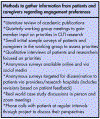Engaging patients and their caregivers in research to improve evidence-based, patient-centered and equitable care for chronic limb-threatening ischemia and advanced peripheral artery disease
- PMID: 40642754
- PMCID: PMC12245146
- DOI: 10.1016/j.jvsvi.2025.100222
Engaging patients and their caregivers in research to improve evidence-based, patient-centered and equitable care for chronic limb-threatening ischemia and advanced peripheral artery disease
Abstract
Chronic limb-threatening ischemia (CLTI) is the end stage of advanced peripheral artery disease (PAD), a condition that is estimated to affect more than 200 million individuals globally. CLTI poses significant risks to many patients, particularly those from underserved populations (e.g., racial/ethnic minorities, low-income individuals, and rural populations) who experience significant disparities in care and outcomes, including higher rates of amputation, reduced quality of life, and lower survival rates. In 2021, the non-profit Foundation to Advance Vascular Cures, with support from the Patient Centered Outcomes Research Institute (PCORI), created a working group made up of patients, caregivers, researchers, industry experts, and non-profit advocates to develop a roadmap to increase patient engagement in CLTI research. Following a literature review, the working group used surveys, interviews, collaborative discussions, and focus groups to gain information from multiple stakeholder groups over a two-year period. This project built capacity on education and learning with the key observations presented. Our observations include: (1) early engagement of patients and caregivers in the research process improves the study design and enables more meaningful research; (2) frequent interpersonal contact paired with targeted, minimally burdensome education in research and disease increases meaningful engagement of patients with CLTI and their caregivers; (3) building trust between patients, caregivers, and researchers is essential to the success of these initiatives; (4) qualitative research complements quantitative results because it can lead to a nuanced understanding of patient experiences, goals, and perspectives; and (5) patients and caregivers are more likely to engage when research-related information is easy to access and has low burden in terms of time and resources. These observations underscore the need for stakeholder input to research design as well as the plans of funders and investigators in this field. Stakeholders noted the particular need for outreach to traditionally underrepresented and underserved populations, with whom more research is needed to meaningfully address health disparities.
Keywords: Chronic limb-threatening ischemia (CLTI); Health disparities; Patient engagement; Peripheral artery disease (PAD); Stakeholder collaboration.
Conflict of interest statement
Patrick Geraghty, MD has the following disclosures: he holds stock or stock options in Cordis/MedAlliance, Aveera, and Protexa. Additionally, he receives research funding from InspireMD, which is directed to Washington University for his role as a trial Principal Investigator; no funds are received personally. Samantha Minc, MD, MPH is supported by grants from the National Institute of Diabetes and Digestive and Kidney Diseases (K23DK128569) and the Society for Vascular Surgery Foundation/American College of Surgeons. The content is the sole responsibility of the authors and does not necessarily represent the official views of the National Institutes of Health, the Society for Vascular Surgery Foundation, or the American College of Surgeons. Manesh R. Patel, MD, has received research grants from Bayer, Idorsia, Novartis, and the National Heart, Lung, and Blood Institute (NHLBI). He has also served on advisory boards or provided consulting for Bayer, Janssen, and Idorsia.Michael S. Conte, MD serves as the Chief Medical Officer (CMO) and Isabel Bjork, JD, MS serves as the Chief Executive Officer of the Foundation to Advance Vascular Cures. The rest of the authors have no conflicts of interest.
Figures



Similar articles
-
How lived experiences of illness trajectories, burdens of treatment, and social inequalities shape service user and caregiver participation in health and social care: a theory-informed qualitative evidence synthesis.Health Soc Care Deliv Res. 2025 Jun;13(24):1-120. doi: 10.3310/HGTQ8159. Health Soc Care Deliv Res. 2025. PMID: 40548558
-
Sexual Harassment and Prevention Training.2024 Mar 29. In: StatPearls [Internet]. Treasure Island (FL): StatPearls Publishing; 2025 Jan–. 2024 Mar 29. In: StatPearls [Internet]. Treasure Island (FL): StatPearls Publishing; 2025 Jan–. PMID: 36508513 Free Books & Documents.
-
Parents' and informal caregivers' views and experiences of communication about routine childhood vaccination: a synthesis of qualitative evidence.Cochrane Database Syst Rev. 2017 Feb 7;2(2):CD011787. doi: 10.1002/14651858.CD011787.pub2. Cochrane Database Syst Rev. 2017. PMID: 28169420 Free PMC article.
-
Factors that influence parents' and informal caregivers' views and practices regarding routine childhood vaccination: a qualitative evidence synthesis.Cochrane Database Syst Rev. 2021 Oct 27;10(10):CD013265. doi: 10.1002/14651858.CD013265.pub2. Cochrane Database Syst Rev. 2021. PMID: 34706066 Free PMC article.
-
Addressing Inequalities in Long Covid Healthcare: A Mixed-Methods Study on Building Inclusive Services.Health Expect. 2025 Aug;28(4):e70336. doi: 10.1111/hex.70336. Health Expect. 2025. PMID: 40600494 Free PMC article.
References
-
- Hemphill R, Forsythe LP, Heckert AL, Amolegbe A, Maurer M, Carman KL, Mangrum R, Stewart L, Fearon N, Esmail L. What motivates patients and caregivers to engage in health research and how engagement affects their lives: qualitative survey findings. Health Expect. 2020. Apr;23(2):328–336. doi: 10.1111/hex.12979. Epub 2019 Dec 4. - DOI - PMC - PubMed
-
- Fowkes FG, Rudan D, Rudan I, Aboyans V, Denenberg JO, McDermott MM, et al. Comparison of global estimates of prevalence and risk factors for peripheral artery disease in 2000 and 2010: a systematic review and analysis. Lancet. 2013. Oct 19;382(9901):1329–1340. doi: 10.1016/S0140-6736(13)61249-0. - DOI - PubMed
-
- Allison MA, Armstrong DG, Goodney PP, Hamburg NM, Kirksey L, Lancaster KJ, Mena-Hurtado CI, Misra S, Treat-Jacobson DJ, White Solaru KT; American Heart Association Council on Peripheral Vascular Disease; Council on Hypertension; and Council on Lifestyle and Cardiometabolic Health. Health disparities in peripheral artery disease: a scientific statement from the American Heart Association. Circulation. 2023. Jul 18;148(3):286–296. doi: 10.1161/CIR.0000000000001153. Epub 2023 Jun 15. - DOI - PMC - PubMed
Grants and funding
LinkOut - more resources
Full Text Sources
